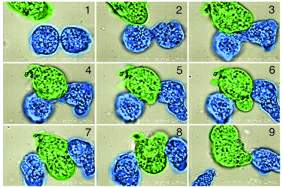Are you a journalist? Please sign up here for our press releases
Subscribe to our monthly newsletter:

Giving birth has never been easy. Nature seems to have decided that whoever wants to procreate should make an effort. Sometimes the process of birth, the physical separation from offspring, is so difficult that a mother needs a helping hand. And humans are not alone in this trait, as recently reported in Nature. An interdisciplinary research team at the Weizmann Institute has discovered that "midwives" also play a role in the microscopic world of amoebas. It is this collaborative birth process that has given amoebas an evolutionary edge.
Amoebas are single-celled organisms that reproduce asexually. Reproduction occurs when an amoeba doubles its genetic material, creates two nuclei, and starts to change in shape, forming a narrow "waist" at its middle. This process usually continues until the final separation into two cells. However, Weizmann Institute scientists found that in one type of amoeba this separation process stalls just before its completion. The two cells remain connected by a narrow tether, which they have difficulty severing using the normal cleavage mechanism. Until recently scientists envisioned only two possible scenarios at this fateful stage. In the first, the two cells, the "mother" and the "daughter," tug at their connecting tether, stretching it until it breaks and each can start a life of its own. In the second scenario, the two tug at the tether but fail to disconnect. After a while they give up and revert to being a single cell, which now has two nuclei.
A collaborative study by physicists and biologists at the Weizmann Institute has now revealed a third scenario, involving a "midwife" amoeba.
Prof. Elisha Moses of the Physics of Complex Systems Department had been studying the mechanical and physical aspects of how living cells separate. He discussed his work with Prof. David Mirelman, Dean of the Biochemistry Faculty, who, among other projects, investigates the properties of amoebas. Mirelman suggested that they examine how amoebas - which multiply faster than most other eukaryotic cells - separate.
The study took place in Moses' lab, which is equipped with sophisticated systems for observing and documenting the physical processes taking place at the level of a single cell. Much to their surprise the team found that in a significant number of cases, when the two amoebas have trouble disconnecting, a third amoeba rushes to their aid. This amoeba squeezes between them, exerting pressure until the "umbilical cord" snaps and each amoeba is free to go its own way.
The research team, which included graduate students David Biron, Pazit Libros, and Dror Sagi, went on to show that the struggling amoebas send out a chemical cry for help. When amoebas are placed in a culture flask and fluid is collected near the narrow "waist" of a dividing amoeba and subsequently released elsewhere in the flask, it causes other amoebas to flock to that spot - just like midwives responding to a call from a woman in labor. The phenomenon was even more pronounced when the scientists merely moved the tip of the pipette containing the attracting substance around in the flask, causing the amoebas to "chase" it.
The scientists believe that the chemical signal released by a dividing amoeba is a unique complex substance present in the amoeba's membrane, consisting of a lipid, a protein fragment, and some sugars. When an amoeba is trying to divide, the membrane in the area of its narrow "waist" stretches, undergoing enormous stress. This mechanical perturbation may cause the substance to be released into the nearby environment, thus "alerting" the "midwife" amoebas to come to the aid of the dividing amoeba.
The researchers plan to further investigate this phenomenon, in particular the precise composition of the attractant, its mechanism of release by amoebas undergoing division, and the nature of the "midwife's" receptor. This study may contribute to future attempts to control amoeba-borne infectious diseases, such as dysentery, through new therapies targeting amoeba reproduction.